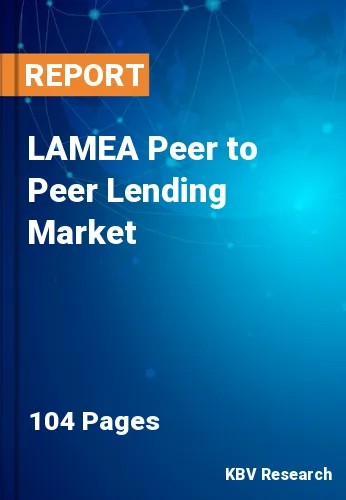The Latin America, Middle East and Africa Peer to Peer Lending Market would witness market growth of 30.8% CAGR during the forecast period (2023-2030).
In recent years, the financial sector has experienced a surge of transformation, with technology playing a central role in reshaping traditional lending models. Peer-to-peer (P2P) lending platforms have emerged as disruptors, revolutionizing how individuals and small businesses access loans and investments. This market has gained immense popularity for its ability to provide a decentralized, efficient, and inclusive alternative to the conventional banking system.
P2P lending has made obtaining personal loans simpler and more flexible. Individuals can apply for loans to meet various needs, such as debt consolidation, medical expenses, education, or home improvement. The absence of a bank in the equation often leads to more competitive interest rates and faster loan approval. Small and medium-sized enterprises (SMEs) need help seeking financing from traditional banks. P2P lending platforms have emerged as lifelines for these businesses, offering a convenient way to secure working capital, expand operations, or launch new products or services.
SMEs in the Middle East region is increasingly participating in international trade. Export-oriented businesses have opportunities to reach global markets, expanding their growth prospects. Major cities in the region have been developing startup ecosystems with incubators, accelerators, co-working spaces, and networking events. These environments nurture a culture of entrepreneurship. According to the Government of UAE data, as of mid-2022, the number of small & medium enterprises in the UAE was 557,000. SMEs contribute as much as 63.5 percent to the non-oil GDP. It is forecasted that there will be 1 million SMEs in the UAE by 2030. Thus, the expansion of SMEs, MSEs, and startups in countries like Brazil and UAE is expected to drive the expansion of the region's peer-to-peer lending market.
The Brazil market dominated the LAMEA Peer to Peer Lending Market by Country in 2022, and would continue to be a dominant market till 2030; thereby, achieving a market value of $15,241.4 Million by 2030. The Argentina market is showcasing a CAGR of 31.5% during (2023 - 2030). Additionally, The UAE market would register a CAGR of 30.5% during (2023 - 2030).
Based on Business Model, the market is segmented into Traditional Lending, and Alternate Marketplace Lending. Based on Loan Type, the market is segmented into Small Business Loans, Consumer Credit Loans, Real estate Loans, and Student Loans. Based on End User, the market is segmented into Business, and Personal. Based on countries, the market is segmented into Brazil, Argentina, UAE, Saudi Arabia, South Africa, Nigeria, and Rest of LAMEA.
Free Valuable Insights: The Worldwide Peer to Peer Lending Market is Projected to reach USD 1.1 Trillion by 2030, at a CAGR of 28%
The market research report covers the analysis of key stake holders of the market. Key companies profiled in the report include Harmoney Corp Limited, Funding Circle Limited (Funding Circle Holdings plc), LendingTree, LLC (LendingTree, Inc.), Upstart Network, Inc. (Upstart Holdings, Inc), LendingClub Bank (LendingClub Corporation), goPeer Corporation, Linked P2P Limited, Prosper Funding LLC (Prosper Marketplace, Inc.), Lending Loop (Loop Financial Inc.), and MoneyMe Limited.
By Business Model
By Loan Type
By End User
By Country
Our team of dedicated experts can provide you with attractive expansion opportunities for your business.

